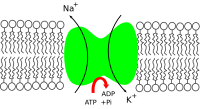
Photo from wikipedia
Multiple 24-hour urine collections are necessary to adequately assess sodium and potassium intake. Here, we assessed kidney function decline for four years after baseline in relation to seven-time averaged 24-hour… Click to show full abstract
Multiple 24-hour urine collections are necessary to adequately assess sodium and potassium intake. Here, we assessed kidney function decline for four years after baseline in relation to seven-time averaged 24-hour urinary sodium and potassium excretion (UNaV, UKV), their UNaV/UKV ratio, and their categorical combination in outpatients with chronic kidney disease (CKD). This retrospective cohort study was based on 240 outpatients with baseline CKD stages 3-5, baseline age 20 years or more (median age 72.0 years), and a median follow-up (with interquartile range) of 2.9 (1.4- 4.0) years. Outcome was the percentage change in annual slope of estimated glomerular filtration rate (delta eGFR per year). In linear mixed models, percentage changes in delta eGFR per year were -3.26% (95% confidence interval -5.85 to -0.60), +5.20% (2.34 to 8.14), and -5.20% (-7.64 to -2.69), respectively, per one standard deviation increase in the seven-time averaged UNaV and UKV, and their UNaV/UKV ratio. Additionally, percentage changes per year in delta eGFR per year were -16.27% (-23.57 to -8.27) in the middle-to-high UNaV and low UKV group, compared with the low UNaV and middle-to high UKV group. Thus, our study reinforces the observation of opposite associations between GFR decline and urinary excretion rates of sodium (positive) and potassium (negative), respectively. Whether changes in dietary sodium and potassium intake slow GFR decline still requires further study.
Journal Title: Kidney international
Year Published: 2021
Link to full text (if available)
Share on Social Media: Sign Up to like & get
recommendations!